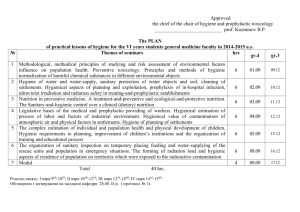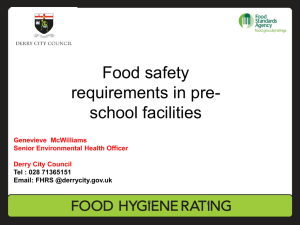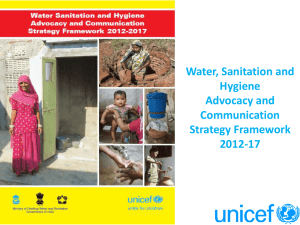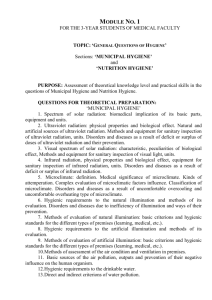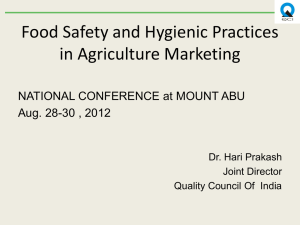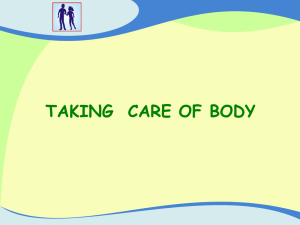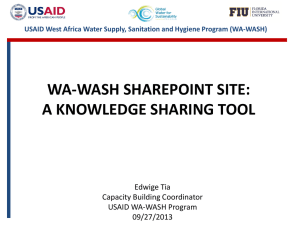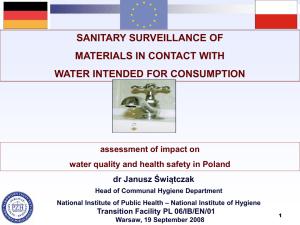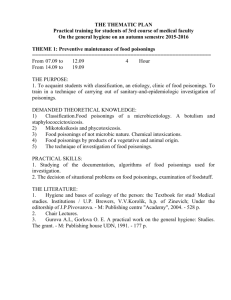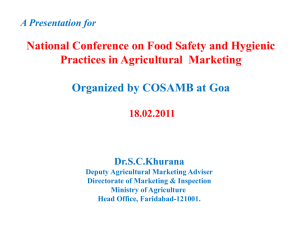human hygiene and ecology as a branch of medical science, health
advertisement
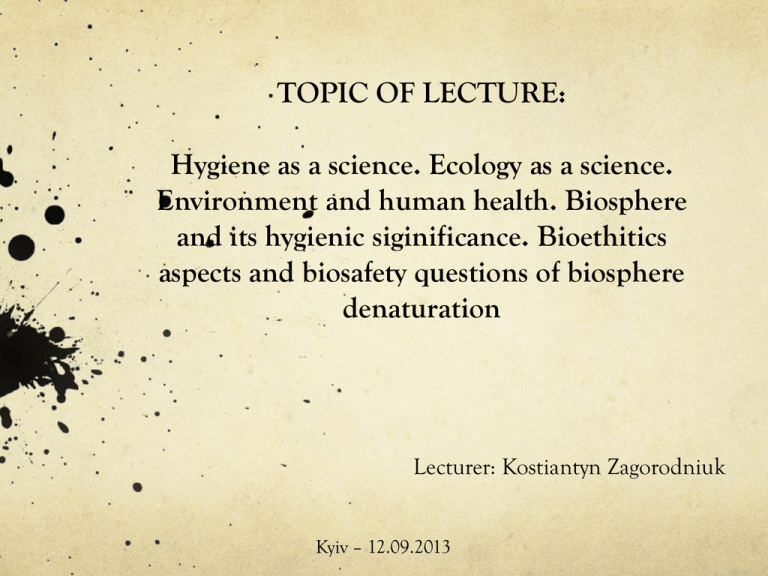
TOPIC OF LECTURE: Hygiene as a science. Ecology as a science. Environment and human health. Biosphere and its hygienic siginificance. Bioethitics aspects and biosafety questions of biosphere denaturation Lecturer: Kostiantyn Zagorodniuk Kyiv – 12.09.2013 PLAN OF THE LECTURE Introduction to hygiene and human ecology. Organizational and methodological provisions for studying general hygiene and human ecology at the department. Health as object of hygiene. Environment as an object of hygiene. Prophylactic priorities in medicine. Hygiene as a science. Definitions, aims, tasks, methods of hygiene. Historical outline of hygiene development. Sanitation. Kinds of sanitation. Sanitary and epidemiological services in Ukraine. Sanitary legislation in Ukraine. Significance of hygienic knowledge for medical profession. THE IDEAS OF PROPHYLAXIS IN SCIENTIFIC WORKS The main task of a doctor is about care of healthy people so that they don’t fall in disease. Hippocrates (IV century B.C.) The primary task of a doctor lies in preventing a disease; if you have failed to manage it – treat it; if the disease is incurable – alleviate suffering. Botkin S.P. (1867) I believe in hygiene. This is where real progress of our science lies. The future belongs to preventive medicine. Pirogov M.P. (1887) THE IDEAS OF PROPHYLAXIS IN SCIENTIFIC WORKS A doctor must not only treat patients, but also prevent diseases; that is the ideal side of his mission; it`s the best and the most useful side of his activity. Erismann F.F. (1887) The more experienced the practical physician is the better he understands the omnipotence of hygiene and relative weakness of curative medicine. Only hygiene can win the dispute with the disease. Zakharyin G.A. (1910) PROPHYLAXIS Prophylaxis comprises a wide network of state, medical and public measures aimed at protecting and improving people’s health, bringing up healthy young population, improving human working ability and active longevity. Prophylaxis Social (public) Provided for State measures established in the Constitution (the right to work, housing, study etc.) Individual (personal) Fighting nervous, vascular, endocrine and other systems overloading of an individual Prophylaxis Primary Prophylactic technologies for disease prevention by removing risk factors (causes and conditions of disease development) and improving body resistance to risk factors Secondary Medico-prophylactic technologies for revealing disease, preventing its progress, aggravation and possible complications Tertiary Medico-prophylactic technologies aimed at removing negative consequences of the disease (relapses, complications, temporary or permanent disability, death) HYGIENE (basic) H Y G І E N E is a branch of medical knowledge, a science dealing with protecting and consolidating social (collective) and personal (individual) health by means of prophylactic measures. H Y G І E N E is a branch of medicine, a science that studies laws of environmetal and its interaction on human organism and health of the society with the aim of substantiating hygienic standards, sanitary rules and measures which will provide the optimal conditions for vital functions, health consolidation and disease prevention. ECOLOGY Ecology (from Greek: οἶκος, "house"; -λογία, "study of”) is the scientific study of interactions among organisms and their environment, such as the interactions organisms have with each other and with their abiotic environment. SHELLS OF THE EARTH Atmosphere (New Latin atmosphaera, created in the 17th century from Greek ἀτμός [atmos] "vapor“ and σφαῖρα [sphaira] "sphere”) is a layer of gases surrounding a material body of sufficient mass of Earth that is held in place by the gravity of the Earth body. Hydrosphere (from Greek ὕδωρ - hudōr, "water” and σφαῖρα - sphaira, "sphere”) is combined mass of water found on, under, and over the surface of planet Earth Lithosphere (Greek: λίθος [lithos] for "rocky", and σφαῖρα [sphaira] for "sphere") is the rigid outermost shell of a rocky planet Earth. Biosphere – this is total sum of ecosystems on the planet. Ecological relationships regulate the flux of energy, nutrients, and climate all the way up to the planetary scale. For example, the dynamic history of the planetary atmosphere's CO2 and O2 composition has been affected by the biogenic flux of gases coming from respiration and photosynthesis, with levels fluctuating over time in relation to the ecology and evolution of plants and animals. MAIN OBJECTIVE OF HYGIENE Preserving and strengthening of the human’s health TASKS OF HYGIENE ① Studying the natural and anthropogenic environmental factors and specific conditions affecting the health of a human being. ② Studying objective laws of the impact of environmental factors and conditions on the human body and population. ③ Scientific substantiation and development of hygienic standards, rules and measures for rational use of environmental factors beneficial for human body as well as removing the harmful factors or limiting them to safe levels. ④ Implementation of developed hygienic recommendations, rules and standards into practice in national economy, controlling and improving their effectiveness. ⑤ Predicting the sanitary situation for nearest and remote future, taking into account plans for their development of national economy, proper hygienic problems arising from the prognosed situation, scientific research of the problem. SPECIFIC METHODS OF HYGIENE Epidemiological (study of the human’s health). Method of sanitary examination and description. Method of hygienic experiment: a. Method of natural experiment; b. Method of laboratory experiment. Method of sanitary examination and /or expertise. Method of hygienic teaching and study, sanitary education. STAGES OF HYGIENIC DEVELOPMENT IN UKRAINE STAGES OF HYGIENIC DEVELOPMENT IN UKRAINE SANITARY LEGISLATION OF UKRAINE 1. 2. 3. 4. 5. 6. 7. 8. State Constitution (1996). Health protection laws. The Law „On sanitary and epidemic welfare of the population” (1995). Laws and Government resolutions on nature, air, water and soil protection. State standards on industrial production, foodstuffs, medicines quality (State Standards, certification of quality). Building standards and rules (BSaR). Sanitary rules and standards (SanRaS). Hygienic standards: maximum allowable concentration (MAC), maximum allowable level (MAL), maximum allowable dose (MAD), approximately safe influence level (ASIL), safe residual quality (SRQ), technical terms (TT). WHAT REQUIRES THE KNOWLEDGE OF HYGIENE State of population health analysis connected with living conditions. Diagnostics, defining etiology and pathogenesis of alimentary, professional and infectious diseases. Administering treatment (in treatment-and-prophylactic institutions) and treatmentand-prophylactic (in dangerous enterprises) diet that assist in removing harmful substances from the body, rises the body resistance to their action. Professional orientation (establishing correction of health level and chosen profession), medical expert examination. Recommendations on daily regimen and personal hygiene. Intrahospital infection prevention. Conducting sanitary-educational work with people (in treatment-and-prophylactic establishments), in pediatric establishments (pediatric doctor), enterprises (medical dispensary doctor), in rural conditions (rural district doctor). METHODS OF HYGIENIC STUDIES SCHEME OF COMPLEX EVALUATION OF HEALTH STATE INTERCONECTION OF HYGIENE WITH THE OTHER SCIENCES SANITATION School (preschool) S А N І Housing and municipal Industrial Foodstuffs Т Sanitation is controlled by А Sanitation is executed by T І Sanitary-epidemiological services The whole population (personal sanitation) State organs State and private enterprises O N Institutions and establishments Agricultural enterprises, farmers Trade unions and other organizations STRUCTURE OF SANITARYEPIDEMIOLOGICAL SERVICE OF UKRAINE STRUCTURE SANITARYEPIDEMIOLOGICAL STATION Thank You for Your Attention!
